Eugene Kharitonov
Dima
Gemma 3 Technical Report
Mar 25, 2025Abstract:We introduce Gemma 3, a multimodal addition to the Gemma family of lightweight open models, ranging in scale from 1 to 27 billion parameters. This version introduces vision understanding abilities, a wider coverage of languages and longer context - at least 128K tokens. We also change the architecture of the model to reduce the KV-cache memory that tends to explode with long context. This is achieved by increasing the ratio of local to global attention layers, and keeping the span on local attention short. The Gemma 3 models are trained with distillation and achieve superior performance to Gemma 2 for both pre-trained and instruction finetuned versions. In particular, our novel post-training recipe significantly improves the math, chat, instruction-following and multilingual abilities, making Gemma3-4B-IT competitive with Gemma2-27B-IT and Gemma3-27B-IT comparable to Gemini-1.5-Pro across benchmarks. We release all our models to the community.
MAD Speech: Measures of Acoustic Diversity of Speech
Apr 16, 2024



Abstract:Generative spoken language models produce speech in a wide range of voices, prosody, and recording conditions, seemingly approaching the diversity of natural speech. However, the extent to which generated speech is acoustically diverse remains unclear due to a lack of appropriate metrics. We address this gap by developing lightweight metrics of acoustic diversity, which we collectively refer to as MAD Speech. We focus on measuring five facets of acoustic diversity: voice, gender, emotion, accent, and background noise. We construct the metrics as a composition of specialized, per-facet embedding models and an aggregation function that measures diversity within the embedding space. Next, we build a series of datasets with a priori known diversity preferences for each facet. Using these datasets, we demonstrate that our proposed metrics achieve a stronger agreement with the ground-truth diversity than baselines. Finally, we showcase the applicability of our proposed metrics across several real-life evaluation scenarios. MAD Speech will be made publicly accessible.
AudioPaLM: A Large Language Model That Can Speak and Listen
Jun 22, 2023



Abstract:We introduce AudioPaLM, a large language model for speech understanding and generation. AudioPaLM fuses text-based and speech-based language models, PaLM-2 [Anil et al., 2023] and AudioLM [Borsos et al., 2022], into a unified multimodal architecture that can process and generate text and speech with applications including speech recognition and speech-to-speech translation. AudioPaLM inherits the capability to preserve paralinguistic information such as speaker identity and intonation from AudioLM and the linguistic knowledge present only in text large language models such as PaLM-2. We demonstrate that initializing AudioPaLM with the weights of a text-only large language model improves speech processing, successfully leveraging the larger quantity of text training data used in pretraining to assist with the speech tasks. The resulting model significantly outperforms existing systems for speech translation tasks and has the ability to perform zero-shot speech-to-text translation for many languages for which input/target language combinations were not seen in training. AudioPaLM also demonstrates features of audio language models, such as transferring a voice across languages based on a short spoken prompt. We release examples of our method at https://google-research.github.io/seanet/audiopalm/examples
SoundStorm: Efficient Parallel Audio Generation
May 16, 2023Abstract:We present SoundStorm, a model for efficient, non-autoregressive audio generation. SoundStorm receives as input the semantic tokens of AudioLM, and relies on bidirectional attention and confidence-based parallel decoding to generate the tokens of a neural audio codec. Compared to the autoregressive generation approach of AudioLM, our model produces audio of the same quality and with higher consistency in voice and acoustic conditions, while being two orders of magnitude faster. SoundStorm generates 30 seconds of audio in 0.5 seconds on a TPU-v4. We demonstrate the ability of our model to scale audio generation to longer sequences by synthesizing high-quality, natural dialogue segments, given a transcript annotated with speaker turns and a short prompt with the speakers' voices.
Speak, Read and Prompt: High-Fidelity Text-to-Speech with Minimal Supervision
Feb 07, 2023Abstract:We introduce SPEAR-TTS, a multi-speaker text-to-speech (TTS) system that can be trained with minimal supervision. By combining two types of discrete speech representations, we cast TTS as a composition of two sequence-to-sequence tasks: from text to high-level semantic tokens (akin to "reading") and from semantic tokens to low-level acoustic tokens ("speaking"). Decoupling these two tasks enables training of the "speaking" module using abundant audio-only data, and unlocks the highly efficient combination of pretraining and backtranslation to reduce the need for parallel data when training the "reading" component. To control the speaker identity, we adopt example prompting, which allows SPEAR-TTS to generalize to unseen speakers using only a short sample of 3 seconds, without any explicit speaker representation or speaker-id labels. Our experiments demonstrate that SPEAR-TTS achieves a character error rate that is competitive with state-of-the-art methods using only 15 minutes of parallel data, while matching ground-truth speech in terms of naturalness and acoustic quality, as measured in subjective tests.
AudioLM: a Language Modeling Approach to Audio Generation
Sep 07, 2022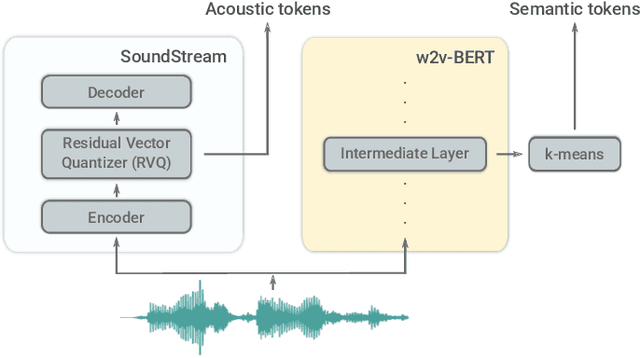

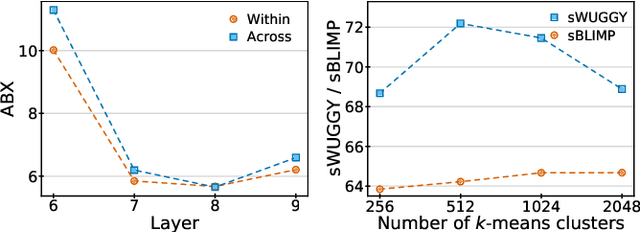

Abstract:We introduce AudioLM, a framework for high-quality audio generation with long-term consistency. AudioLM maps the input audio to a sequence of discrete tokens and casts audio generation as a language modeling task in this representation space. We show how existing audio tokenizers provide different trade-offs between reconstruction quality and long-term structure, and we propose a hybrid tokenization scheme to achieve both objectives. Namely, we leverage the discretized activations of a masked language model pre-trained on audio to capture long-term structure and the discrete codes produced by a neural audio codec to achieve high-quality synthesis. By training on large corpora of raw audio waveforms, AudioLM learns to generate natural and coherent continuations given short prompts. When trained on speech, and without any transcript or annotation, AudioLM generates syntactically and semantically plausible speech continuations while also maintaining speaker identity and prosody for unseen speakers. Furthermore, we demonstrate how our approach extends beyond speech by generating coherent piano music continuations, despite being trained without any symbolic representation of music.
Generative Spoken Dialogue Language Modeling
Mar 30, 2022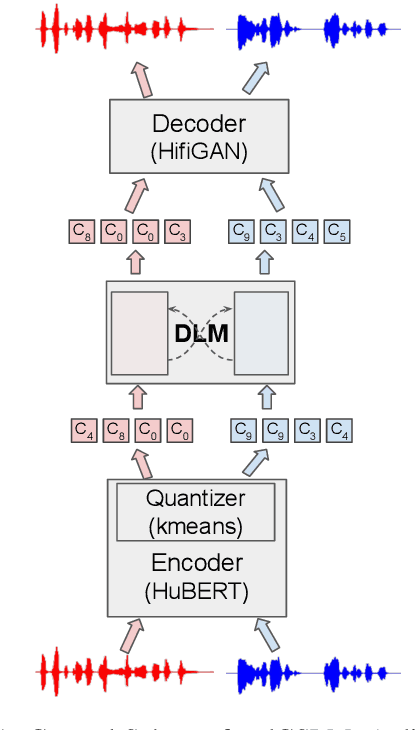
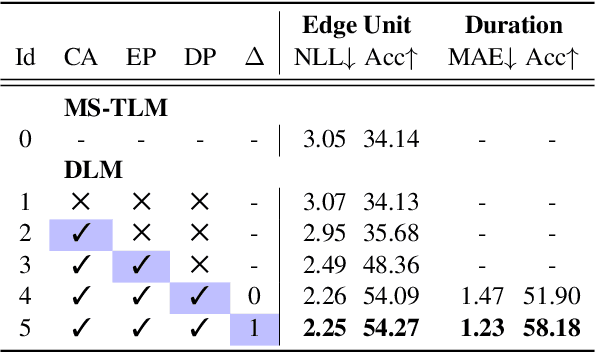
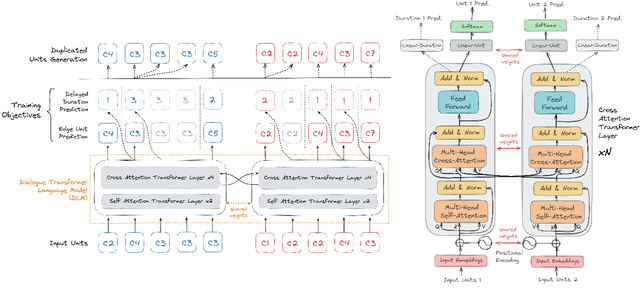
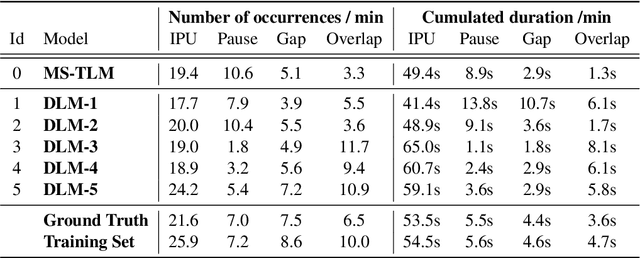
Abstract:We introduce dGSLM, the first "textless" model able to generate audio samples of naturalistic spoken dialogues. It uses recent work on unsupervised spoken unit discovery coupled with a dual-tower transformer architecture with cross-attention trained on 2000 hours of two-channel raw conversational audio (Fisher dataset) without any text or labels. It is able to generate speech, laughter and other paralinguistic signals in the two channels simultaneously and reproduces naturalistic turn taking. Generation samples can be found at: https://speechbot.github.io/dgslm.
textless-lib: a Library for Textless Spoken Language Processing
Feb 15, 2022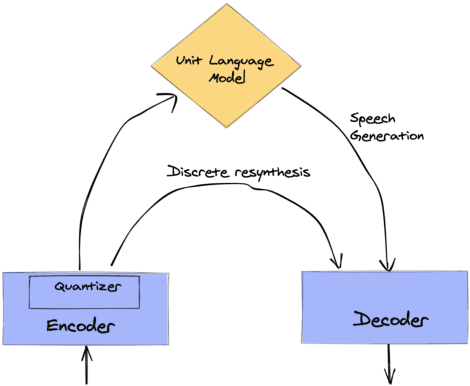
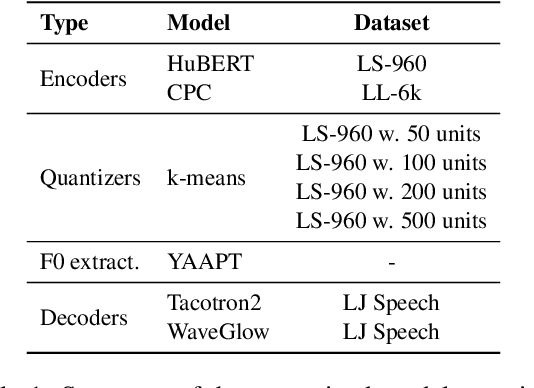

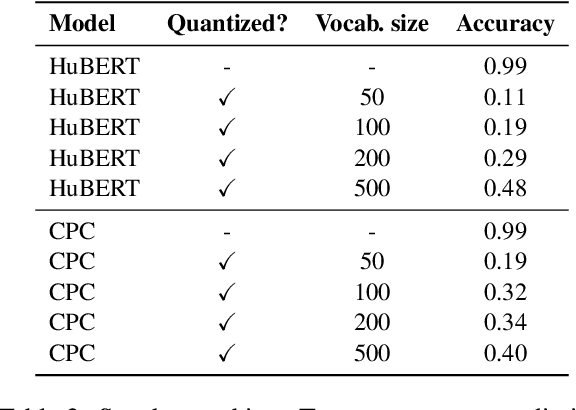
Abstract:Textless spoken language processing research aims to extend the applicability of standard NLP toolset onto spoken language and languages with few or no textual resources. In this paper, we introduce textless-lib, a PyTorch-based library aimed to facilitate research in this research area. We describe the building blocks that the library provides and demonstrate its usability by discuss three different use-case examples: (i) speaker probing, (ii) speech resynthesis and compression, and (iii) speech continuation. We believe that textless-lib substantially simplifies research the textless setting and will be handful not only for speech researchers but also for the NLP community at large. The code, documentation, and pre-trained models are available at https://github.com/facebookresearch/textlesslib/ .
Textless Speech Emotion Conversion using Decomposed and Discrete Representations
Nov 14, 2021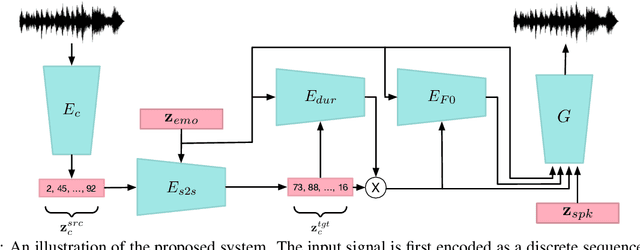
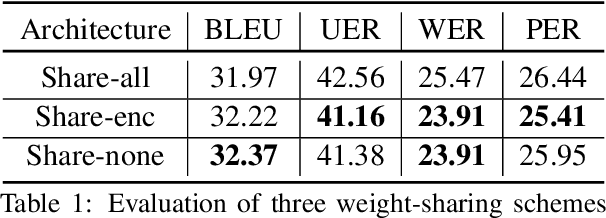
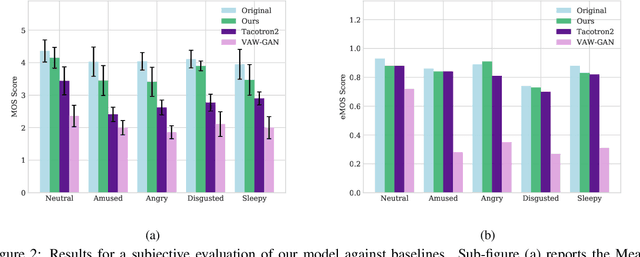
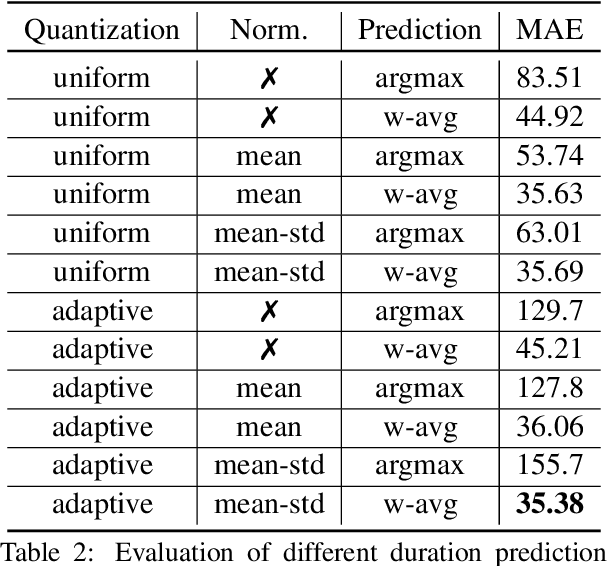
Abstract:Speech emotion conversion is the task of modifying the perceived emotion of a speech utterance while preserving the lexical content and speaker identity. In this study, we cast the problem of emotion conversion as a spoken language translation task. We decompose speech into discrete and disentangled learned representations, consisting of content units, F0, speaker, and emotion. First, we modify the speech content by translating the content units to a target emotion, and then predict the prosodic features based on these units. Finally, the speech waveform is generated by feeding the predicted representations into a neural vocoder. Such a paradigm allows us to go beyond spectral and parametric changes of the signal, and model non-verbal vocalizations, such as laughter insertion, yawning removal, etc. We demonstrate objectively and subjectively that the proposed method is superior to the baselines in terms of perceived emotion and audio quality. We rigorously evaluate all components of such a complex system and conclude with an extensive model analysis and ablation study to better emphasize the architectural choices, strengths and weaknesses of the proposed method. Samples and code will be publicly available under the following link: https://speechbot.github.io/emotion.
How BPE Affects Memorization in Transformers
Oct 06, 2021



Abstract:Training data memorization in NLP can both be beneficial (e.g., closed-book QA) and undesirable (personal data extraction). In any case, successful model training requires a non-trivial amount of memorization to store word spellings, various linguistic idiosyncrasies and common knowledge. However, little is known about what affects the memorization behavior of NLP models, as the field tends to focus on the equally important question of generalization. In this work, we demonstrate that the size of the subword vocabulary learned by Byte-Pair Encoding (BPE) greatly affects both ability and tendency of standard Transformer models to memorize training data, even when we control for the number of learned parameters. We find that with a large subword vocabulary size, Transformer models fit random mappings more easily and are more vulnerable to membership inference attacks. Similarly, given a prompt, Transformer-based language models with large subword vocabularies reproduce the training data more often. We conjecture this effect is caused by reduction in the sequences' length that happens as the BPE vocabulary grows. Our findings can allow a more informed choice of hyper-parameters, that is better tailored for a particular use-case.
 Add to Chrome
Add to Chrome Add to Firefox
Add to Firefox Add to Edge
Add to Edge